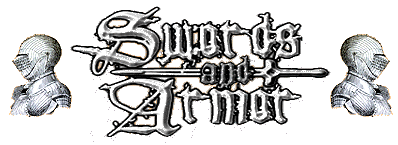
Shield Displays - A Touch of Old
In a land far away, in an age long
past, knights battled over land and kingdoms while blacksmiths slaved over hot
fires to produce the protection that these brave souls needed and the weapons to
help them conquer their enemies.
The shield was needed for defensive moves to protect from arrows and to deflect
the punch of a maul or a thrust from a sword. However, in a battle, where there
is no uniform appearance to your own soldiers-in-arms and the enemies, how did
you tell foe from friend? Many of the disputes were between neighboring towns or
close lands that shared most of the same styles and customs. It was easy to tell
against wars with other cultures who was who, but how to tell if your enemy
shared your language, your clothing, your lands?
Shield identifications probably started off for individuals who were the
stronger fighters and leaders, who eventually obtained followers who began to
wear that leader’s identification rather than their own, or perhaps a slightly
individualized version with the individual putting a part of himself on his own
shield. These identifications were at first very simple. Simply various colors
and lines, eventually chevrons and then someone began to tell the tale of the
leader on their shields. What symbol did his House use for their name? Did they
fight like a wolf and somewhere in antiquity take on that symbol for their
household? Were they good in land battles or were they seaman? Did they raise
animals that needed protection or lands with landmarks that stood out? Were they
royal or a servant of another liege? Did they come from a certain castle?
All of these images began to be applied to the shield for identification. Part
of a good squire’s job was to reapply these images to the shield as these would
wear off over time and wear and tear of battle. Simpler designs were used in
battle while a more complex pattern may have ended up on the walls of the castle
or woven into banners and eventually, developed into the coat of arms for the
individual knights.
Soon these simpler designs gave way to more multifaceted ones and probably the
squires groaned inwardly at seeing the complexities of the designs. But each
shield told a story and those schooled in the language of heraldry could read
these symbols to tell the story of the man who they represented, down to the
last dot which in itself has meaning; since most people could not read or write,
even the commoner could read a shield well enough to know who it belonged to and
to act accordingly. A soldier whose job required him to know who was who in a
battle was probably only aware of colors and styles as he was busy with such
small details as kill or be killed.
The shield with standard colors and design was begun in the medieval period
around 1100 AD with the Norman conquerors but flourished all over Europe by the
Renaissance era. With the sparked interest in art and design of that age, the
shields became works of art, still retaining the ability to tell the stories of
its owner but more grandiose and more stylized in its story. These were awarded
by a liege to his best warriors or those in high places who wished to
acknowledge someone for their deeds. Even the clergy had this system of reward
and certain stations carried its own shield requirement, even in the Church.
Today, a revived interest in family crests and creating one’s own family crest
has renewed interest in these patterns from old. Sadly, too many now ignore the
language of the herald, simply picking and choosing symbols for their style or
beauty or personal meaning, yet this does not differ too much from the
beginnings of the shield when symbols were picked for their significance to that
person. The language of heraldry, fast becoming a lost art, has come full circle
in our time and is beginning all over again with a new language; whether it will
stabilize and once again be a language to read or if the shields will simply be
something appealing to appreciate is still to be seen.
Shield displays are still admired by many and like any work of art, inspire and
tantalize the mind with their stories. Like paintings, they tell a story to the
viewer. This particular form of art tells the history of battles and war that
still echo in the halls of imagination. They speak of glory and dust and blood
and bravery. They speak of the valor and persistence of men now long dead that
live still in the hearts of their descendants. But most of all, they tell us the
stories of a time long past that we hunger to know for these are the symbols of
those descended from the mighty conquerors of Western Europe, who turned chaos
into the mightiest civilizations in history during a time known as the Medieval
Ages.
shields Index
Medieval Shields
Swords and Armor Home
Medieval Crests
Swords and Armor Specials !
New Introductions - Closeouts
- All Great Bargains
Contact
Us Via Email
Shipping Policies
and Rates - Returns
Payment Methods
We accept most major credit cards and PayPal
copyright
2001-2014 swordsandarmor.com . All Rights Reserved
privacy policy
